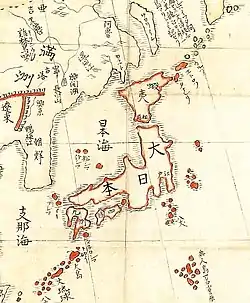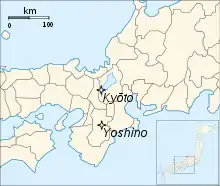Enbun
Enbun (延文), also transcribed Embun,[1] was a Japanese era name (年号, nengō, lit. year name) of the Northern Court during the Era of Northern and Southern Courts after Bunna and before Kōan. This period spanned the years from March 1356 through March 1361;[2] The emperor in Kyoto was Emperor Go-Kōgon (後光厳天皇, Go-Kōgon-tennō).[3] Go-Kōgon's Southern Court rival in Yoshino during this time-frame was Emperor Go-Murakami (後村上天皇, Go-Murakami-tennō)
| History of Japan |
|---|
 |
Nanboku-chō overview
During the Meiji period, an Imperial decree dated March 3, 1911 established that the legitimate reigning monarchs of this period were the direct descendants of Emperor Go-Daigo through Emperor Go-Murakami, whose Southern Court (南朝, nanchō) had been established in exile in Yoshino, near Nara.[4]
Until the end of the Edo period, the militarily superior pretender-Emperors supported by the Ashikaga shogunate had been mistakenly incorporated in Imperial chronologies despite undisputed recognition that the Imperial Regalia were not in their possession.[4]
This illegitimate Northern Court (北朝, hokuchō) had been established in Kyoto by Ashikaga Takauji.[4]
Change of era
- 1356, also called Enbun gannen (延文元年): The new era name was created to mark an event or series of events. The previous era ended and the new one commenced in Bunna 5.[5]
In this time frame, Shōhei (1346–1370) was the Southern Court equivalent nengō.
Events of the Enbun era
- 1356 (Enbun 1, 7th month): Minamoto no Michisuke was advanced from the court rank of dainagon to naidaijin.[6]
- 1356 (Enbun 1, 7th month): Ashikaga Yoshinori is raised to the second rank of the third class in the court hierarchy.[7]
- 1357 (Enbun 2, 2nd month): Emperor Go-Murakami, who had captured former-Emperor Kōgon, former-Emperor Kōmyō and former-Emperor Sukō in 1352, released all three of them and permitted their return from Yoshino to Kyoto.[7]
- 1358 (Enbun 3): Death of Ashikaga Takauji;[8] Ashikaga Yoshiakira appointed shōgun; dissention and defections in shogunate.[9]
Notes
- Nussbaum, Louis-Frédéric et al. (2005). "Embun" in Japan encyclopedia, p. 175; n.b., Louis-Frédéric is pseudonym of Louis-Frédéric Nussbaum, see Deutsche Nationalbibliothek Authority File.
- Nussbaum, p. 175; n.b., ignoring typo -- era continues until March 1361 per NengoCalc Archived September 30, 2007, at the Wayback Machine, and see Nussbaum, Kōan, p. 535.
- Titsingh, Isaac. (1834). Annales des empereurs du japon, pp. 302-305; Nussbaum, p. 175.
- Thomas, Julia Adeney. (2001). Reconfiguring modernity: concepts of nature in Japanese political ideology, p. 199 n57, citing Mehl, Margaret. (1997). History and the State in Nineteenth-Century Japan. p. 140-147.
- Titsingh, p. 302.
- Titsingh, p. 303; n.b., Minamoto no Michisuke (源通相, 1326-1371) of the Koga family (久我家) will rise to become daijō daijin in 1366-1368.
- Titsingh, p. 303.
- Titsingh, p. 304.
- Ackroyd, Joyce. (1982) Lessons from History: The Tokushi Yoron, p.329.
References
- Ackroyd, Joyce. (1982) Lessons from History: The Tokushi Yoron. Brisbane: University of Queensland Press. ISBN 978-0-7022-1485-1
- Mehl, Margaret. (1997). History and the State in Nineteenth-Century Japan. New York: St Martin's Press. ISBN 978-0-312-21160-8; OCLC 419870136
- Nussbaum, Louis Frédéric and Käthe Roth. (2005). Japan Encyclopedia. Cambridge: Harvard University Press. ISBN 978-0-674-01753-5; OCLC 48943301
- Thomas, Julia Adeney. (2001). Reconfiguring Modernity: Concepts of Nature in Japanese Political Ideology. Berkeley: University of California Press. ISBN 978-0-520-22854-2; OCLC 47916285
- Titsingh, Isaac. (1834). Nihon Odai Ichiran; ou, Annales des empereurs du Japon. Paris: Royal Asiatic Society, Oriental Translation Fund of Great Britain and Ireland. OCLC 5850691
External links
- National Diet Library, "The Japanese Calendar" -- historical overview plus illustrative images from library's collection
| Preceded by Bunna |
Era or nengō Enbun 1356–1361 |
Succeeded by Kōan |

